Research progress and prospect of relationship between double bottom simulating reflector and the accumulation of gas hydrates
-
摘要:
双BSR已成为国际水合物研究的新热点,其在水合物成藏机制、分布富集规律及水合物钻采站位优选等方面有着重要意义。国际上对双BSR的研究主要集中于双BSR的识别、成因机制及其与水合物成藏关系的研究几个方面,但存在双BSR的识别方法和技术有限,双BSR形成机制不明及保存机理不清等诸多难题,尤其是将双BSR与水合物-游离气体系统一起来开展水合物动态成藏研究尚处于探索阶段。中国南海海域已发现双BSR存在的证据,然而研究程度极低且严重滞后,亟需开展双BSR识别与刻画,双BSR成因机制及影响因素分析,双BSR形成变化与水合物动态成藏关系及双BSR对多类型水合物勘探开发影响等方面的研究。阐明双BSR与水合物动态成藏关系并建立动态演化的水合物-天然气体系模式,为深入研究双BSR及水合物成因机制、分布规律及其地质历史中的演变提供重要的科学依据,亦可深化水合物成藏理论研究并推进水合物勘探开发。
Abstract:The double bottom simulating reflector (DBSR), which is important for the accumulation mechanism, distribution and enrichment characteristics as well as drilling and exploitation site optimization of gas hydrates, has become a new international research hotspot. The research on the DBSR abroad mainly focuses on the recognition, formation mechanism and the relationship with the accumulation of gas hydrates; nevertheless, the mechanism of DBSR is still ambiguous. Especially, the unification of DBSR with hydrates and free gases for carrying out the study of the dynamic accumulation of gas hydrates remains at the exploratory stage. Evidence of DBSR has been found in the South China Sea, but the research on them has been very insufficient and seriously lagged. Therefore, it is an urgent need to carry out the study of the recognition and depiction, the formation mechanism and controlling factors, the developing and evolution of DBSR and their relations with the dynamic accumulation of gas hydrates, as well as the effect of DBSR on the exploration and exploitation of multiple-type gas hydrates. The investigation of the relationship between DBSR and the dynamic accumulation of gas hydrates and establishment of the dynamic evolution models of the gas hydrate-free gas system will provide important scientific basis for the intensive research on the genetic mechanism, distribution regularities and geological evolution of the DBSR and gas hydrates. The research on reservioring theories as well as exploration and development of gas hydrates can also promote and develop the research.
-
1. 引言
天然气水合物(水合物,下同)可以有效黏结碎屑颗粒,降低沉积物孔隙度,改变沉积物的物理性质,提高水合物富集层的声波传播速度(Singh et al., 1993; Mackay et al., 1994),当水合物稳定带(GHSZ:Gas Hydrate Stability Zone)下部含有游离气时,在GHSZ底面与游离气的顶面之间可形成一个波阻抗差很大的物理界面,产生强地震反射,由于其在地震剖面上表现为近似平行于海底展布的且反射极性与海底相反的反射面,因此被称为似海底反射层——BSR(Bottom Simulating Reflector) (Hyndman and Davis, 1992; Haacke et al., 2007)。海域形成的水合物与BSR密切相关,其是目前使用最多、最直观、且相对可靠的识别水合物赋存的地球物理标志(Miller et al., 1991; Hyndman et al., 1992; Paull and Dillon, 2001; Bünz et al., 2003; Hornbach et al., 2003; Majumdar et al., 2016)。BSR通常被认为是水合物稳定域的底界,代表了水合物赋存的下限深度(Ganguly et al., 2000; Klitzke et al., 2016)。
随着研究程度的加深及水合物勘探资料的丰富,科学家逐渐发现在同一地震剖面上BSR并非只有一层,而可能出现两(双)层甚至多层在垂向上上下叠置的BSR(图 1) (Posewang and Mienert, 1999; Andreassen et al., 2000; Foucher et al., 2002; Popescu et al., 2006; Geletti and Busetti, 2011; Zander et al., 2017)。所谓双BSR,即在同一地震剖面上同时出现上下叠置的两层BSR(为表述方便,统一称为上BSR和下BSR),通常上BSR代表了现今活跃的水合物稳定域底界,与根据现今海底的温度、压力等条件估算的甲烷水合物稳定带的底界相对应,被称为现行的甲烷水合物BSR(active methane hydrate BSR) (Foucher et al., 2002; Auguy et al., 2017),而下BSR可能代表盆地原有温度和压力稳定带底界,即原始或“古”水合物稳定域底界。同时,上BSR反射极性与海底反射极性相反,而下BSR反射极性可能与海底的反射极性相反(Foucher et al., 2002),也可能与海底反射极性相同(Posewang and Mienert, 1999)。双BSR的出现,突破了以往认为BSR(上BSR)即是水合物分布的底界的认识,实际上通过钻井证实在上BSR下部也存在有水合物(Paganoni et al., 2016; Wei et al., 2018)。
 图 1. 世界水合物赋存区双(多)BSR地震反射特征a—挪威Storegga滑坡区多BSR,据Posewang and Mienert, 1999;b—南海海槽双BSR,据Baba and Yamada, 2004;c—俄勒冈岸外水合物脊双BSR,据Bangs et al., 2005;d—马尼拉俯冲带增生楔双BSR,据Wu et al., 2005;e—南极洲罗斯海西部双BSR,据Geletti and Busetti, 2011;f—黑海多BSR,据Popescu et al., 2006Figure 1. Seismic reflection characteristics of the double/multiple BSR in the gas hydrate occurrence districts in the worlda-Multiple BSR in the Storegga slide area west of Norway, after Posewang and Mienert, 1999; b-Double BSR in the Nanhai Trough, after Baba and Yamada, 2004; c-Double BSR in the southern Hydrate Ridge offshore Oregon, after Bangs et al., 2005; d-Double BSR in the accretionary wedge of the Manila subduction zone, after Wu et al., 2005; e-Double BSR in the western Ross Sea, Antarctica, after Geletti and Busetti, 2011; f-Multiple BSR in the Black Sea, after Popescu et al., 2006
图 1. 世界水合物赋存区双(多)BSR地震反射特征a—挪威Storegga滑坡区多BSR,据Posewang and Mienert, 1999;b—南海海槽双BSR,据Baba and Yamada, 2004;c—俄勒冈岸外水合物脊双BSR,据Bangs et al., 2005;d—马尼拉俯冲带增生楔双BSR,据Wu et al., 2005;e—南极洲罗斯海西部双BSR,据Geletti and Busetti, 2011;f—黑海多BSR,据Popescu et al., 2006Figure 1. Seismic reflection characteristics of the double/multiple BSR in the gas hydrate occurrence districts in the worlda-Multiple BSR in the Storegga slide area west of Norway, after Posewang and Mienert, 1999; b-Double BSR in the Nanhai Trough, after Baba and Yamada, 2004; c-Double BSR in the southern Hydrate Ridge offshore Oregon, after Bangs et al., 2005; d-Double BSR in the accretionary wedge of the Manila subduction zone, after Wu et al., 2005; e-Double BSR in the western Ross Sea, Antarctica, after Geletti and Busetti, 2011; f-Multiple BSR in the Black Sea, after Popescu et al., 2006越来越多水合物赋存的国家和地区发现了双BSR或多BSR现象,通过地震资料的解释,在挪威西部大陆边缘(Posewang and Mienert, 1999)、日本南海海槽(Baba and Yamada, 2004)、马尼拉俯冲带(Wu et al., 2005)、俄勒冈岸外水合物脊(Bangs et al., 2005)、南极洲罗斯海(Geletti and Busetti, 2011)、黑海Danube深海扇(Posescu et al., 2006; Zander et al., 2017)、印度尼西亚海岸带(Zhang and Wright, 2017)等地区发现了双(多)BSR(图 1)。科学家在双BSR识别分析方法、成因机制及控制影响因素、双BSR与水合物分布和成藏等方面已开展了广泛的探讨和研究(Tréhu et al., 1999; Baba and Yamada, 2004; Tréhu et al., 2004; Bangs et al., 2005; Posescu et al., 2006; Geletti and Busetti, 2011; Li et al., 2015; Zander et al., 2017; Zhang and Wright, 2017),其在水合物地质理论研究,钻探站位优选等方面取得诸多研究成果,有力指导了世界水合物勘探。然而,国际上有关双BSR形成演变与水合物动态成藏关系的研究欠缺;中国双BSR研究程度则更低,尚处于概念介绍和定性描述阶段(苏新, 2000; 宋海斌等, 2003a, 2003b; 龚建明等, 2010),针对中国海域双BSR的识别、分布特征、成因机制及其与水合物动态成藏关系等方面的研究薄弱,极大制约了中国水合物地质理论研究的深化和进步;在南海水合物试开采成功背景下(王力峰等, 2017; Li et al., 2018),亟需对双BSR与水合物动态成藏关系展开深入研究,以加深南海水合物成藏地质理论研究的认识并有效指导后续水合物钻探试采站位优选及钻井工程设计,以提高钻采成功率。
2. 双似海底反射层研究进展
尽管科学家已经发现双BSR与水合物成藏关系密切,并且认识到双BSR在水合物成藏机制及勘探开发研究中的重要作用,但双BSR的研究程度总体偏低,国内外对双BSR的研究主要集中于双BSR的识别、成因机制及其与水合物成藏关系研究等几个方面,但是将双BSR与水合物−游离气体系统一起来开展水合物动态成藏研究尚处于探索阶段,诸多科学问题还有待进一步深化研究。
2.1 双BSR在天然气水合物成藏研究中的重要作用
2.1.1 双BSR是指示水合物赋存的有力和直接证据,是水合物钻探试采重要参考依据
一方面,双BSR可能是多层水合物赋存的证据和直接指示,是勘探海域水合物资源的重要依据和目标,根据双BSR地质地球物理特征,可初步判断水合物及游离气分布范围、深度、类型及饱和度等(Hyndman and Davis, 1992; Hyndman et al., 1992; Zillmer et al., 2005; Horozal et al., 2009; Paganoni et al., 2016; Cordero et al., 2016)。另一方面,双BSR的出现指示可能存在Ⅰ型、Ⅱ型等多类型水合物,即水合物气源可能有多种供给来源和成因(Posewang and Mienert, 1999; Andreassen et al., 2000),这对水合物成藏机制及资源评价等研究有重要意义。此外,双BSR出现的区域,水合物层及相关游离气层等分布更为复杂(Tréhu et al., 1999; Geletti and Busetti, 2011),其对海域水合物钻探站位优选及钻井设计等参数的确定将提出更高的要求,在全球水合物逐步由勘探走向试开采的趋势下,双BSR研究对水合物开采井位优选、工程设计、开采方式选择、风险防控等方面至关重要(Liang et al., 2017a; Zhang and Wright, 2017)。
2.1.2 双BSR的形成演化研究是揭示水合物稳定域变迁的重要途经
双BSR的存在说明形成水合物的温压等稳定条件在地质历史时期曾发生过变化,但又重新进入平衡状态,其为水合物成藏有关的盆地构造演化、沉积演变等地质问题的研究提供了新的信息(Bangs et al., 2005; Golmshtok and Sdoviev, 2006; Zander et al., 2017)。双BSR可以揭示水合物形成和分解与温压变化的关系,水合物分解产生自由气体和水并向海底逸散而形成气烟囱、泥底辟及海底麻坑等构造(图 1e,图 2,图 4)(Geletti and Busetti, 2011; Le et al., 2015),甚至可能造成沉积物变形及海底滑塌(图 1a,图 4a)(Mienert et al., 1998; Posewang and Mienert, 1999),水合物分解后的大量气体释放到大气中,引起温室效应,造成海平面变化、海底温压及全球气候变化,反过来又影响水合物稳定条件,引起水合物稳定域的变迁。
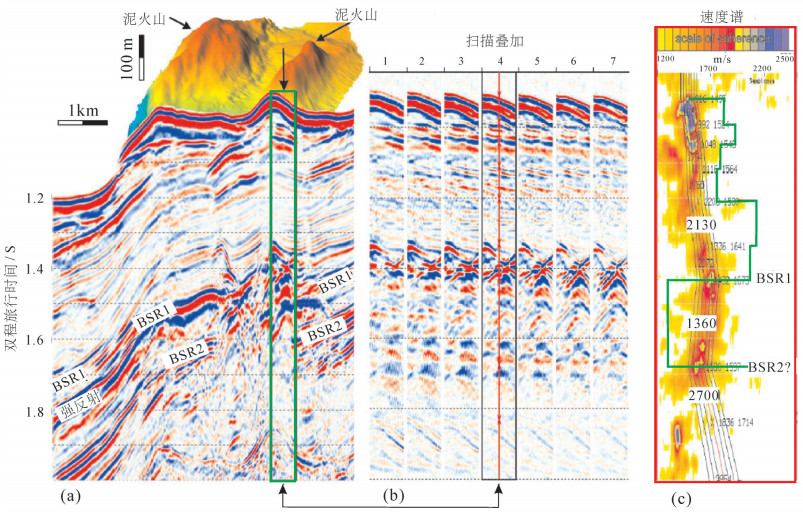 图 2. 罗斯海地区双BSR地震反射特征(a)、扫描叠加(b)及速度谱分析(c)(据Geletti and Busetti, 2010)Figure 2. Seismic reflection features (a), scan stacks (b) and relative semblance velocity analysis (c) of the double BSR in the Ross Sea (after Geletti and Busetti, 2010)
图 2. 罗斯海地区双BSR地震反射特征(a)、扫描叠加(b)及速度谱分析(c)(据Geletti and Busetti, 2010)Figure 2. Seismic reflection features (a), scan stacks (b) and relative semblance velocity analysis (c) of the double BSR in the Ross Sea (after Geletti and Busetti, 2010)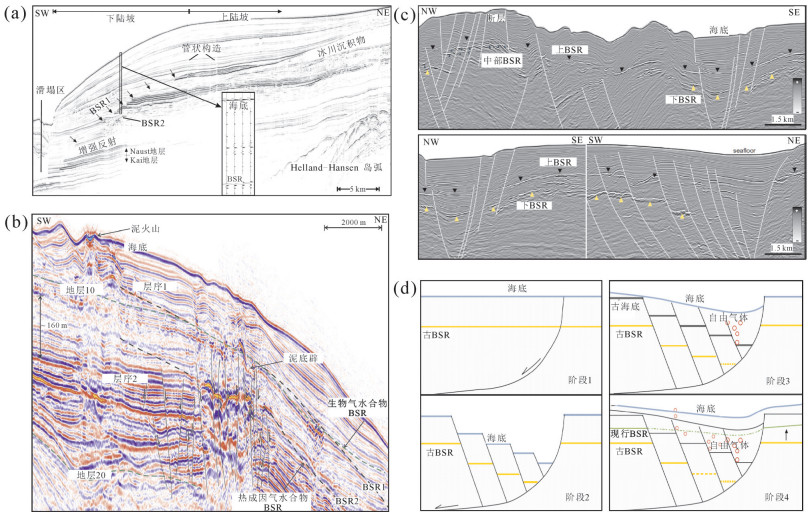 图 4. 双BSR形成影响地质因素a—Storegga滑塌区双BSR(Bünz et al., 2003);b—印度尼西亚边缘Kutei盆地双BSR(据Zhang and Wright, 2018);c—秘鲁大陆边缘多BSR(据Auguy et al., 2017);d—构造沉降及断层活动对双BSR形成的影响模式(据Auguy et al., 2017)Figure 4. Geological factors affecting the formation and preservation of double BSRa-Double BSR in the Storegga slide area (after Bünz et al., 2003); b-Double BSR in the Kutei Basin offshore Indonesia (after Zhang and Wright, 2018); c-Multiple BSR offshore Peru (after Auguy et al., 2017); d-Diagram showing how tectonic subsidence and sedimentation influence the formation of the double BSR (after Auguy et al., 2017)
图 4. 双BSR形成影响地质因素a—Storegga滑塌区双BSR(Bünz et al., 2003);b—印度尼西亚边缘Kutei盆地双BSR(据Zhang and Wright, 2018);c—秘鲁大陆边缘多BSR(据Auguy et al., 2017);d—构造沉降及断层活动对双BSR形成的影响模式(据Auguy et al., 2017)Figure 4. Geological factors affecting the formation and preservation of double BSRa-Double BSR in the Storegga slide area (after Bünz et al., 2003); b-Double BSR in the Kutei Basin offshore Indonesia (after Zhang and Wright, 2018); c-Multiple BSR offshore Peru (after Auguy et al., 2017); d-Diagram showing how tectonic subsidence and sedimentation influence the formation of the double BSR (after Auguy et al., 2017)2.1.3 双BSR与水合物−天然气体系动态演化密切相关
水合物钻探加深了BSR与水合物、游离气分布关系的认识,而双BSR的形成演变为精细刻画多个水合物层、游离气层的分布和变化,水合物气源供给和疏导及其与水合物温压稳定域时空耦合配置等研究提供了新的素材(Baba and Yamada, 2004; 阮爱国等, 2006; Popescu et al., 2006; Haacke et al., 2007)。然而,国内外对动态演化的水合物−天然气体系的研究不足,双BSR的出现可望指示一个地质历史演变中动态演化的水合物成藏系统特征,且是研究水合物二次成藏机制的绝佳对象(宋海斌等, 2003a),对于水合物成藏理论的研究有重要推进作用,也是非常亟需的。
总之,开展双BSR的研究,可为深入了解水合物形成机制、分布规律及其地质历史中的动态成藏与演变提供重要信息,同时可以为海域水合物钻采站位优选提供地质决策依据,以提高水合物钻探试采成功率,因而具有重要的经济、环境和科学意义,双BSR的研究也因此成为国际水合物地质勘探研究的重点和新热点。
2.2 双BSR国内外研究重点与存在的问题
2.2.1 双BSR的识别方法和技术有限
BSR的识别方法和技术在国际上研究较为广泛和深入,但是双BSR与BSR存在诸多异同点,利用识别BSR的方法和技术来识别和分析双BSR并不能完全适用,但诸如AVO分析及全波形反演等方法也有诸多可借鉴之处(Pecher et al., 1996; Yuan et al., 1999; Carcione and Tinivella, 2000; 宋海斌等, 2003b; 阮爱国等, 2006; 张尧声等, 2015)。目前,双BSR的识别和判识主要是依据二维或三维地震资料的解释和判识,通过地震波波形、振幅、频率、速度、反射极性等手段识别双BSR(图 1)。与单BSR识别不同的是,双BSR的识别必须确定下部BSR的真实性,即双BSR之一的下BSR确实是与水合物有关的BSR,解决方法主要是通过全波形反演和速度分析来确定。Andreassen et al. (2000)利用Singh et al. (1993)提出的全波形反演方法研究了挪威西部大陆边缘双BSR的速度结构,认为双BSR对应速度从1.8km/s降低到1.4 km/s的区域,在双BSR下方的低速带指示游离气的存在,他们认为低速带顶部与底部的反射干涉导致了双BSR之下BSR不是负极性的特征。宋海斌等(2003b)、Song et al. (2003)自主建立了一种用于水合物BSR研究的全波形反演方法,并首次给出了日本东南海海槽增生楔双BSR的高分辨率速度结构,从而正确地解释了双BSR的反射极性特征。通常,地层中速度出现反转是水合物存在的一个地球物理标志,双BSR的出现会在速度谱上出现2次速度突变和倒转的现象(图 2),因而分析地震叠加速度和层速度是判识双BSR及其埋藏深度和间隔的有效方法(Geletti and Busetti, 2010)。然而地层速度拾取精度和准确度将制约判定双BSR的有效性。当下BSR上下界面岩性及含气或水合物饱和度差异极小时,地层速度变化微弱,因而难以从地层速度上准确判识双BSR的存在。此外,当地层中含有碳酸盐岩等沉积层时,可造成地震剖面上出现类似于BSR的强反射且地层速度明显升高,进而可能误判为BSR。
2.2.2 双BSR的成因机制具多解性
双BSR成因的解释还存在争议,在研究早期主要存在“残留说” (Posewang and Mienert, 1999)和多气源组分说(Posewang and Mienert, 1999; Andreassen et al., 2000)两种观点。随着研究的深入,逐渐发展为以下几种观点:①温压条件改变有关(Foucher et al., 2007; Zander et al., 2017)。②气候变化有关(Popescu et al., 2001)。③水合物气源多组分有关(Posewang and Mienert, 1999; Andreassen et al., 2000)。④构造抬升和褶皱作用(Bangs et al., 2005; Haacke et al., 2007)。⑤地层岩性或矿物变化(Foucher et al., 2002; Martin et al., 2004; Musgrave et al., 2006)。
上述双BSR的解释针对不同地区确实有其合理性,但因存在诸多控制影响因素而在全球并不具有普适性。当前,主要研究方法是针对不同区域地质背景,尽可能采用逼近实际地质情况的温度、压力、地温梯度、热流、气体组分等数据建立水合物相平衡曲线模型,模拟计算不同条件下双BSR的分布深度和范围,然后再与实际双BSR的分布深度等对应比较,来推测双BSR的成因(Bangs et al., 2005; Geletti and Busetti, 2010; Li et al., 2015; Pecher et al., 2017)(图 3)。这种方法有其可取的一面,但也存在不确定性。通常现今BSR(上BSR)在地层中稳定连续存在,且与现今的温度场和压力场有较好的吻合关系,但是利用古温度和压力来检验“古” BSR(下BSR)的成因是否与温度、压力改变有关是否合理和准确还存在疑问。理论上,不同气体组分的气源可能会导致双BSR的形成(图 3c),但这一解释也存在争议(宋海斌等,2003):两种不同的、离散的气体组分在相同的沉积物中是怎么过滤出来的?离散气体组分为什么只出现在特定区域而不是广大的区域呢?实际应用时也存在问题:在俄勒冈岸外实施的ODP Leg204航次在水合物脊双BSR发育区钻探结果显示,在上BSR上部钻获了水合物,而在上BSR下部及下BSR上部区间,无论是岩心显示,岩心红外图像热异常还是测井曲线,都显示该区间不存在水合物(Tréhu et al., 2004)。这与不同气体组分形成的双BSR现象及所推测的水合物分布规律相矛盾。
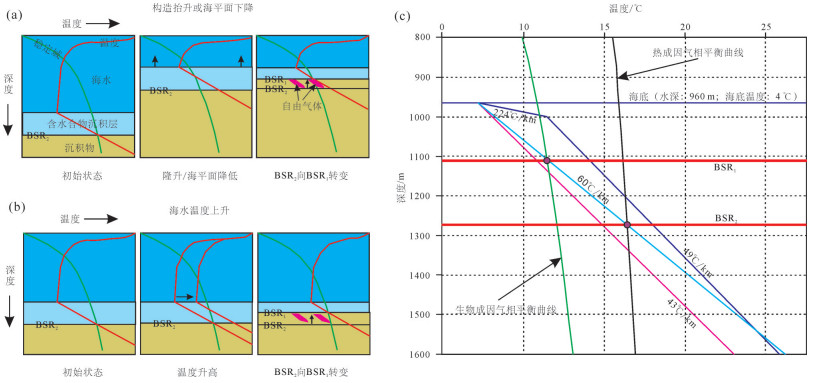 图 3. 水合物温−压模型指示因构造抬升、海平面变化(a),海底温度变化(b)导致双BSR形成机制(据Bangs et al., 2005)及不同气源与地温梯度导致水合物稳定域变迁及双BSR形成(c)(据Zhang and Wright, 2017)Figure 3. Gas hydrate temperature-pressure model showing the formation of double BSR resulting from tectonic uplift, sea-lever change (a), seafloor temperature change (b) (after Bangs et al., 2005). Different hydrate gas compositions and geothermal gradients resulting in the changes of gas hydrate stability zone and the formation of double BSR (c) (after Zhang and Wright, 2017)
图 3. 水合物温−压模型指示因构造抬升、海平面变化(a),海底温度变化(b)导致双BSR形成机制(据Bangs et al., 2005)及不同气源与地温梯度导致水合物稳定域变迁及双BSR形成(c)(据Zhang and Wright, 2017)Figure 3. Gas hydrate temperature-pressure model showing the formation of double BSR resulting from tectonic uplift, sea-lever change (a), seafloor temperature change (b) (after Bangs et al., 2005). Different hydrate gas compositions and geothermal gradients resulting in the changes of gas hydrate stability zone and the formation of double BSR (c) (after Zhang and Wright, 2017)实际上,无论哪种因素引起双BSR的形成和出现,本质上还是BSR界面上下地层岩石物理性质差异造成。温压变化导致地层含水合物或含气的特征发生改变最为普遍,水合物−游离气相态的转变造成的岩石物理性质变化最终可引起双BSR的形成。BSR上覆地层因水合物的富集而具有相对高的地层速度,而BSR下部因地层含气而具有相对低的地层速度,上下地层之间的波阻抗差异最终造成BSR的出现。当原有保持水合物稳定赋存的温压条件改变时,水合物会发生分解,原有含水合物的地层水合物饱和度降低甚至不再含水合物而导致地层含气,因而地层的岩石物理性质将发生改变,当再次出现水合物稳定域时,水合物重新生成聚集,最终会引起双BSR的形成和出现(Pecher et al., 2017)。也有研究学者认为,下BSR是由薄气层引起的,因而表现出与海底极性一致的正极性,而非上BSR的负极性,同时也表明上下BSR之间不一定含有水合物(Andreassen et al., 2000)。研究还发现成岩作用也会引起双BSR的出现,比如蛋白石A向蛋白石CT转变时,由于地层岩性变化,同样会导致地层岩石物理性质的变化。例如Leg127、128航次就在日本海发现蛋白石−A向蛋白石−CT转化形成的BSR(Kuramoto et al., 1992),这一BSR实际上与水合物无关,属于“假BSR”。因此,这种由蛋白石转化造成的BSR假象的识别和解释应十分谨慎。
2.2.3 双BSR保存机理及影响因素不清
一方面,影响水合物稳定域的参数较多,难以精确获取建立模型所需参数,例如形成水合物的气源组分因水合物样品获取难度大且难以准确测定;另一方面,双BSR形成还可能受多因素控制,如日本南海海槽双BSR的产生,被解释为温压稳定域的向上迁移;Foucher et al. (2002)研究认为90 m的构造抬升造成的海底压力降低或1~2℃的海底温度的突然增加造成了水合物温压稳定域的变化,最终引起双BSR的形成,但究竟哪一因素是决定性因素无法确定。挪威大陆边缘Storegga海底滑塌作用及相关的流体活动引起的温压条件的改变同样对该区双BSR的形成和分布产生了重要影响(Bünz et al., 2003)(图 4a)。Zhang and Wright(2017)研究印度尼西亚边缘Kutei盆地水合物时,认为盆地发育的气烟囱及泥底辟等运移输导的热成因气可能引起了双BSR的形成和分布(图 4b)。Auguy et al.(2017)发现秘鲁大陆边缘构造沉降及断层活动明显控制了双BSR的形成和分布,并据此提出了构造沉降活动与双BSR形成的关系模式(图 4c、d)。总之,影响双BSR形成和分布的因素众多,需结合具体地质特征来分析。
双BSR形成并保存的机理如何?这一问题的前提是水合物分解之后形成的自由气体保存的时间能够保证新的BSR的形成,因此研究者关注水合物分解的气体,即下BSR下部聚集的气体保存的时间。Foucher et al. (2002)在假定自由气体没有对流运移的前提下,计算得出下BSR下部的自由气体保存的时间大约为10000 a;Bangs et al. (2005)研究认为,在没有对流或者极少对流的情况下,下BSR下部的自由气体能够保存足够长的稳定时间,进而阻止BSR因水合物分解而快速消失。Auguy et al. (2017)也研究认为尽管双BSR地区水合物发生过分解,但双BSR之下BSR下部的气体含量仍足够多而能够维持BSR长时间保存。上述研究是在没有对流或极少对流的假定条件下开展的,但双BSR发育区往往会出现较强烈的构造活动或者活跃的含气流体活动(Bünz et al., 2003;Geletti and Busetti, 2010; Zhang and Wright, 2017),在这种地质背景下,双BSR是如何形成并长期保存的机理仍旧不清。
2.2.4 双BSR与水合物−天然气体系关系研究薄弱
与单BSR相比,双BSR与水合物成藏关系更为复杂。双BSR的上BSR通常被认为是现今水合物稳定域的底界,下BSR的解释尚未有定论:其可能代表古水合物稳定域底界的BSR残留(Posewang and Mienert, 1999; Foucher et al., 2002; Baba and Yamada, 2004; Bangs et al., 2005),或者是水合物和自由气体之间的过渡带边界(Baba and Yamada, 2004),还有学者认为是水合物层下部自由气体的顶底界面(Tinivella and Giustiniani, 2013)。Song et al. (2003)、宋海斌等(2003b)利用全波形反演方法研究得出的日本东南海海槽双BSR的速度结构表明,双BSR对应有两个速度高于趋势速度的高速带,它们的下方则存在低速度带,上下两个高速到低速的转换边界分别对应上BSR与下BSR。上BSR上方与下BSR上方的高速带与沉积物中含水合物有关,而下BSR下方的低速带与沉积物中含游离气有关。上BSR之下的低速带可以解释成不含水合物的饱和水沉积物或者是含极少游离气的沉积物(宋海斌等, 2003a)。在罗斯海西部海域(Geletti and Busetti, 2010)及黑海海域水合物分布区(Popescu et al., 2006)则证实双BSR下部赋存有丰富的游离气,因而游离气的赋存与双BSR的形成关系密切(图 5)。ODP Leg 204航次钻探结果表明,在俄勒冈岸外水合物脊双BSR发育区,在上BSR的上部稳定域内钻获了水合物,而在上BSR下部却没有钻获水合物,证实上BSR代表了丰富水合物赋存的底部边界,而双BSR之间(下BSR之上)并不一定是水合物赋存段(Tréhu et al., 2004)。Andreassen et al. (2000)研究认为,双BSR下方存在游离气这一特征,容易用不同气源组分水合物沉积底界的反射模型来解释,而用“古” BSR来解释并不容易,因此认为挪威大陆边缘的双BSR与混合气体的水合物有关。值得重视的是,双BSR的形成演变与水合物动态成藏密切相关,且可能牵涉到水合物的分解和二次成藏,对这一问题的研究尚处于探索阶段,水合物发生分解的原因、时间和规模可能通过双BSR的研究得到答案。双BSR的出现,可能指示存在生物气和热成因气等多种类型气源(图 3c,图 4b),即可能赋存有Ⅱ型水合物。上BSR可能代表Ⅰ型水合物的底界,而下BSR则代表Ⅱ型水合物的底界(Bangs et al., 2005)。双BSR区间可能包含有自由甲烷气体和Ⅱ型水合物(Bangs et al., 2005),而双BSR指示的水合物−天然气体系的研究薄弱,双BSR与多层水合物及气层的形成、分布深度及与水合物厚度、饱和度关系等这些问题均值得深入研究和探索。
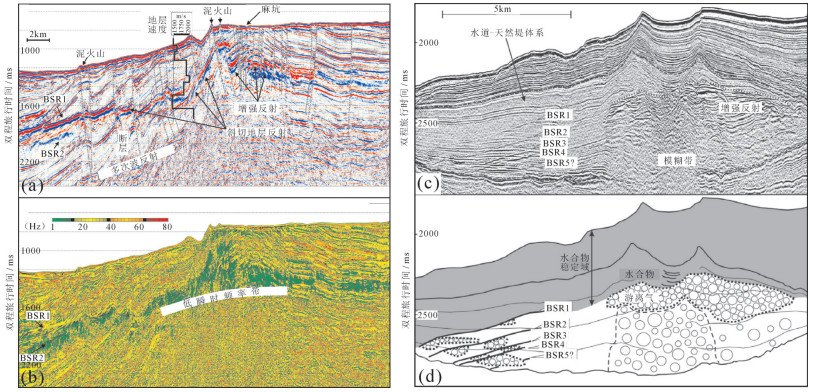 Figure 5. The occurrence relationship between the double/multiple BSR and free gas in the western Ross Sea (a, b; after Geletti and Busetti, 2010) and the Black Sea (c, d; after Popescu et al., 2006)
Figure 5. The occurrence relationship between the double/multiple BSR and free gas in the western Ross Sea (a, b; after Geletti and Busetti, 2010) and the Black Sea (c, d; after Popescu et al., 2006)3. 南海北部双BSR研究进展与存在问题
中国南海北部具有优越的水合物赋存地质条件,有学者在神狐海域,东沙海域,南海东部海域等区域发现了双BSR形成和分布的现象和证据(吴必豪等, 2003; 陈多福等, 2004; 何家雄等, 2015; Li et al., 2015; Liang et al., 2017)。然而,国内双BSR的研究程度较低,仅有的研究也是综述和报道国内外双BSR发现的案例及研究的概况,侧重于双BSR的识别方法的探索(宋海斌等, 2003a; 张尧声等, 2015; 王明等, 2017),对双BSR成因及其与水合物动态成藏关系研究欠缺。Wu et al.(2005)首次在台西南和笔架南盆地东部俯冲增生楔中识别出双BSR,展示出具体地震剖面(图 1d)并指出双BSR的形成指示了水合物热成因气源,但没有开展深入和具体的研究。神狐海域双BSR研究相对深入,龚建明等(2010)在日本东南海槽等地区双BSR研究基础上,提出中国南海北部神狐海域存在双BSR,并通过计算得出双BSR与水深的关系,但在其研究中并没有展示实际的双BSR地震剖面等证据;通过水合物地震探测资料的研究,张光学等(2014)发现了双BSR存在的地球物理证据,并指出双BSR的形成与浅层渗漏型水合物有关。三维地震资料采集和分析进一步证实神狐海域存在双BSR并且与扩散型水合物赋存之间存在复杂的关系(Liang et al., 2017)(图 6a、b)。2015年,广州海洋地质调查局通过水合物钻探,在神狐海域发现BSR下部存在水合物异常现象,不仅突破了以往BSR是水合物赋存底界的认识,而且引起学者重新思考神狐海域水合物的成藏机制(Liang et al., 2017;张伟等, 2018)。双BSR的出现指示了白云凹陷深部热成因气对水合物成藏的贡献,也表明Ⅰ型水合物和Ⅱ型水合物共存,实际水合物样品测试也证实了这一点(Wei et al., 2018;Qian et al., 2018)。双BSR现象也揭示出水合物与游离气多层分布特征,表明神狐海域水合物可能是一个动态成藏的系统。此外,南海东沙海域也存在双BSR,但其可靠程度较低,现有的研究报道也仅是通过地震剖面的简单识别(图 6c、d、e),并通过水合物温压稳定域模型的建立和计算推测双BSR的成因与深部热成因气或者与海底温度和构造抬升导致的温压稳定域变化有关,但缺乏实际的钻探资料的验证(Li et al., 2015)。总之,在近20年时间内,与国际研究相比,中国双BSR研究程度低,基本停留在现象的描述和初步定性解释阶段,这可能与缺乏地震资料等一手资料有关;也有可能是双BSR现象及其重要研究意义尚未引起研究者的重视或者兴趣。针对双BSR识别判识方法、成因机制及其与水合物动态成藏关系等方面的研究欠缺,极大制约了中国海域水合物成藏理论的进步及勘探开发的进程,因此,亟需开展双BSR与水合物成藏关系的系统深入研究。
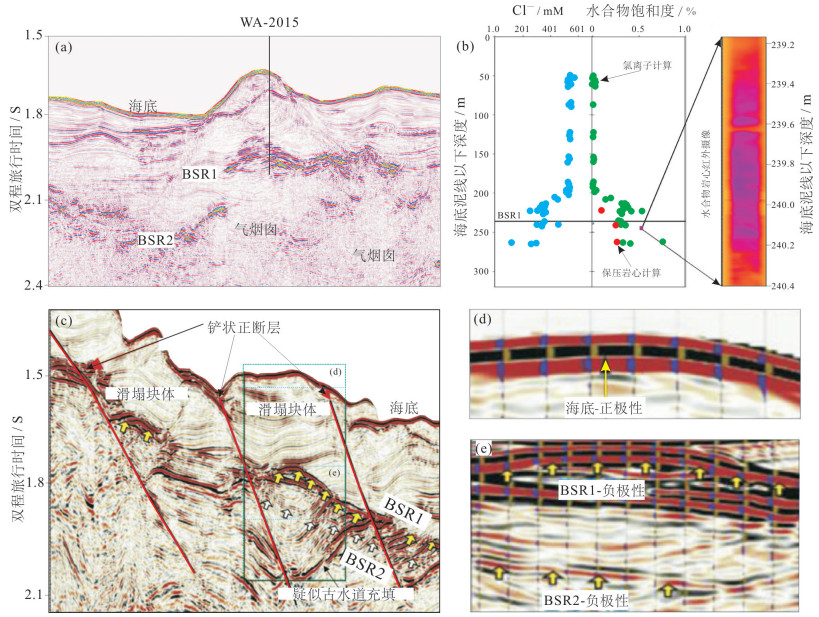 图 6. 南海北部神狐海域双BSR地震反射特征(a),过双BSR站位水合物产出特征(b)(据Liang et al., 2017)及东沙海域双BSR地震反射特征(c, d, e)(据Li et al., 2015)Figure 6. (a) Seismic reflection features of the double BSR in the Shenhu area in northern South China Sea, (b) the occurrence of gas hydrates at the drilling site crossing the double BSR (after Liang et al., 2017), (c, d, e) Seismic reflection features of the double BSR in the Dongsha area (after Li et al., 2015)
图 6. 南海北部神狐海域双BSR地震反射特征(a),过双BSR站位水合物产出特征(b)(据Liang et al., 2017)及东沙海域双BSR地震反射特征(c, d, e)(据Li et al., 2015)Figure 6. (a) Seismic reflection features of the double BSR in the Shenhu area in northern South China Sea, (b) the occurrence of gas hydrates at the drilling site crossing the double BSR (after Liang et al., 2017), (c, d, e) Seismic reflection features of the double BSR in the Dongsha area (after Li et al., 2015)4. 双BSR与水合物成藏关系研究展望
前已述及双BSR在水合物成藏研究中的重要作用和意义,对于今后双BSR与水合物成藏关系研究可解决的关键科学问题主要聚焦于以下几点:(1)双BSR成因机制及影响因素?(2)双BSR形成演变与水合物动态成藏之间的关联如何?(3)双BSR研究如何有效指导水合物勘探开发?具体研究可从以下几个方面开展。
4.1 双BSR识别与成因机制研究
通过高分辨率地震资料的精细解释,合成地震记录及井−震联合反演等技术方法,识别和判识双BSR;通过水合物钻探,验证双BSR的存在及其指示的水合物与游离气分布关系。在此基础上,实验测试分析实钻水合物岩心样品,获取水合物分解气、裂隙气及顶空气样品,分析测试气体组分及同位素特征。通过水合物相平衡曲线及基础参数,建立水合物温−压稳定域相图模型(Li et al., 2015; Paganoni et al., 2016; Liang et al., 2017),分析不同参数变化对双BSR形成及其埋藏深度变化的影响,精确计算双BSR分布深度及间隔距离,综合分析水合物稳定域迁移变化规律。查明泥底辟、气烟囱及断层活动等对局部温压场的影响及对双BSR分布、水合物稳定域变迁影响,最终明确双BSR形成机制及主控因素(苏丕波等, 2017; 张伟等, 2018)。
4.2 双BSR形成变化与水合物动态成藏关系研究
通过双BSR形成与演变的分析,探明双BSR形成和分解时窗,产生的游离气运移及重新聚集形成双BSR及水合物的过程。通过双BSR的刻画与解释,界定水合物、水合物+游离气、游离气分布的垂向分布特征,分析水合物稳定域动态变化与水合物形成和分布的关系;探讨气源的运移疏导及其对水合物成藏的贡献,明确水合物(分布与饱和度)与双BSR变迁时空耦合关系,建立双BSR产生和水合物形成分解动力模型,阐明双BSR与水合物动态成藏机制。
4.3 双BSR对多类型水合物勘探开发影响
双BSR的出现,可能指示水合物成藏系统中双重气源及Ⅰ型、Ⅱ型甚至H型水合物的赋存。热成因气源的供给,将导致水合物稳定域范围的扩大,进而水合物的分布层位和深度将发生改变。这给水合物钻探站位优选及井位设计带来新的思路,也给水合物资源量的评价和计算产生新的要求;同时,不同类型水合物的产出也给水合物开采方式选择带来挑战,比如Ⅱ型水合物比Ⅰ型水合物更为稳定,打破水合物稳定域而生产天然气所需的外界条件将更为苛刻(Wei et al., 2018)。
5. 结论
(1)双似海底反射层(双BSR)的研究在国际天然气水合物地质勘探研究中方兴未艾。开展双BSR的研究,可为深入了解天然气水合物形成机制、分布规律及其地质历史中的动态成藏与演变提供重要信息,同时可以为海域水合物钻采站位优选提供地质决策依据,以提高水合物钻探试采成功率,因而具有重要的经济、环境和科学意义。
(2)国际对双BSR的研究程度总体偏低,主要集中于双BSR的识别、成因机制及其与水合物成藏关系的研究几个方面,但存在双BSR的识别方法和技术有限,双BSR形成影响因素及保存机理不清等诸多难题,尤其是将双BSR与水合物−游离气体系统一起来开展水合物动态成藏研究尚处探索阶段。
(3)双BSR成因的解释还存在争议,主要有“残留说”、温压条件改变、气候变化、水合物气源多组分、构造抬升和褶皱作用、地层岩性或矿物变化等诸多观点,莫衷一是,需结合具体地质背景具体分析。
(4)国内双BSR的研究程度较低,现处于综述和报道国内外双BSR发现的案例及研究概况的阶段,对双BSR的识别方法的探索,双BSR成因及其与水合物动态成藏关系研究欠缺,因此,亟需开展双BSR与水合物成藏关系的系统深入研究。今后双BSR识别与刻画,双BSR成因机制及影响因素分析,双BSR形成变化与水合物动态成藏关系及双BSR对多类型水合物勘探开发影响等方面的研究将有助于中国海域水合物成藏理论的进步并加快水合物勘探开发的进程。
-
图 2 罗斯海地区双BSR地震反射特征(a)、扫描叠加(b)及速度谱分析(c)(据Geletti and Busetti, 2010)
Figure 2.
图 3 水合物温−压模型指示因构造抬升、海平面变化(a),海底温度变化(b)导致双BSR形成机制(据Bangs et al., 2005)及不同气源与地温梯度导致水合物稳定域变迁及双BSR形成(c)(据Zhang and Wright, 2017)
Figure 3.
图 5 罗斯海西部海域(a,b;据Geletti and Busetti, 2010)及黑海海域水合物分布区(c,d;据Popescu et al., 2006)双/多BSR与游离气赋存关系
Figure 5.
图 6 南海北部神狐海域双BSR地震反射特征(a),过双BSR站位水合物产出特征(b)(据Liang et al., 2017)及东沙海域双BSR地震反射特征(c, d, e)(据Li et al., 2015)
Figure 6.
-
Andreassen K, Mienert J, Bryn P, Singh S C. 2000. A double gashydrate related bottom simulating reflector at the Norwegian continental margin[J]. Annals of the New York Academy of Sciences, 912:126-135.
Auguy C, Calvès G, Calderon Y, Brusset S. 2017. Seismic evidence of gas hydrates, multiple BSRs and fluid flow offshore Tumbes Basin, Peru[J].Marine Geophysical Research, 38(4):409-423. doi: 10.1007/s11001-017-9319-2
Baba K, Yamada Y. 2004. BSRs and associated reflections as an indicator of gas hydrate and free gas accumulation:an example of accretionary prism and forearc basin system along the Nankai Trough, off Central Japan[J]. Resource Geology, 54(1):11-24. http://d.old.wanfangdata.com.cn/NSTLQK/10.1111-j.1751-3928.2004.tb00183.x/
Bangs N L B, Musgrave R J, Tréhu A M. 2005. Upward shifts in the southern hydrate ridge gas hydrate stability zone following postglacial warming, offshore Oregon[J]. Journal of Geophysical Research, 110:B(3):1-13. http://cn.bing.com/academic/profile?id=345e9ee5b772c6bfe836ac27f6fbc623&encoded=0&v=paper_preview&mkt=zh-cn
Bünz S, Mienert J, Berndt C. 2003. Geological controls on the storegga gas hydrate system of the mid-Norwegian continental margin[J]. Earth and Planetary Science Letters, 209:291-307. doi: 10.1016/S0012-821X(03)00097-9
Carcione J M, Tinivella U. 2000. Bottom-simulating reflectors:seismic velocities and AVO effects[J]. Geophysics, 65(1):54-67. doi: 10.1190/1.1444725
Chen Duofu, Li Xuxuan, Xia Bin. 2004. Distribution of gas hydrate stable zones and resource prediction in the Qiongdongnan Basin of the South China Sea[J]. Chinese Journal of Geophysics, 47(3):483-489 (in Chinese with English abstract). http://www.wanfangdata.com.cn/details/detail.do?_type=perio&id=10.1002/cjg2.519
de la Cruz Vargas-Cordero I, Tinivella U, Villar-Muñoz L, Giustiniani M. 2016. Gas hydrate and free gas estimation from seismic analysis offshore Chiloé island (Chile)[J]. Andean Geology, 43(3):263-274.
Foucher J P, Nouzé H, Henry P. 2002. Observation and tentative interpretation of a double BSR on the Nankai slope[J].Marine Geology, 187:161-175. doi: 10.1016/S0025-3227(02)00264-5
Ganguly N, Spence G D, Chapman N R, Hyndman R D. 2000. Heat flow variations from bottom simulating reflectors on the Cascadia margin[J]. Marine Geology, 164(1/2):53-68. http://www.wanfangdata.com.cn/details/detail.do?_type=perio&id=1039480da76caf452508760ca8b52f42
Geletti R, Busetti M. 2011. A double bottom simulating reflector in the western Ross Sea, Antarctica[J].Journal of Geophysical Research, 116(B4):1-15. http://cn.bing.com/academic/profile?id=ebd957765b08ac7f29a096f3d9aa8dbf&encoded=0&v=paper_preview&mkt=zh-cn
Golmshtok A Y, Soloviev V A. 2006. Some remarks on the thermal nature of the double BSR[J].Marine Geology, 229:187-198. doi: 10.1016/j.margeo.2006.03.004
Gong Jianming, Li Huijun, Zhang Li, Yan Guijin, Yang Yanqiu, Zhang Jian. 2010. Discussion on the relationship between water depth and double -BSR in marine gas hydrate-bearing sediments[J]. Marine Geology Letters, 26(7):7-11 (in Chinese with English abstract).
Haacke R R, Westbrook G K, Hyndman R D. 2007. Gas hydrate, fluid flow and free gas:Formation of the bottom-simulating reflector[J]. Earth and Planetary Science Letters, 261:407-420. doi: 10.1016/j.epsl.2007.07.008
He Jiaxiong, Su Pibo, Lu Zhenquan, Zhang Wei, Liu Zhijie, Li Xiaotang. 2015. Prediction of gas sources of natural gas hydrate in the Qiongdongnan Basin, northern South China Sea, and its migration, accumulation and reservoir formation pattern[J]. Natural Gas Industry, 35(8):19-29 (in Chinese with English abstract). http://www.wanfangdata.com.cn/details/detail.do?_type=perio&id=trqgy201508003
Hornbach M J, Holbrook W S, Gorman A R, Hackwith K L, Lizarralde D, Pecher I. 2003. Direct seismic detection of methane hydrate on the Blake Ridge[J]. Geophysics, 68:92-100. doi: 10.1190/1.1543196
Horozal S, Lee G H, Yi B Y, Yoo D G, Park K P, Lee H Y, Kim W, Kim H J, Lee K. 2009. Seismic indicators of gas hydrate and associated gas in the Ulleung Basin, East Sea (Japan Sea) and implications of heat flows derived from depths of the bottom-simulating reflector[J]. Marine Geology, 258(1/4):126-138. http://www.wanfangdata.com.cn/details/detail.do?_type=perio&id=4a38aa9de98ba1a0040a20b0768379bc
Huang B, Tian H, Li X, Wang Z, Xiao X. 2016. Geochemistry, origin and accumulation of natural gases in the deepwater area of the Qiongdongnan Basin, South China Sea[J]. Marine and Petroleum Geology, 72:254-267. doi: 10.1016/j.marpetgeo.2016.02.007
Hyndman R D, Davis E E. 1992. A mechanism for the formation of methane hydrate and seafloor bottom-simulating reflectors by vertical fluid expulsion[J]. Journal of Geophysical Research:Solid Earth, 97(B5):7025-7041. doi: 10.1029/91JB03061
Hyndman R D, Foucher J P, Yamano M, Fisher A. 1992. Deep sea bottom-simulating-reflectors:Calibration of the base of the hydrate stability field as used for heat flow estimates[J]. Earth and Planetary Science Letters, 109(3/4):289-301. http://cn.bing.com/academic/profile?id=2480f6a957e3c9f44bd8f7682ad01e44&encoded=0&v=paper_preview&mkt=zh-cn
Klitzke P, Luzi-Helbing M, Schicks J M, Cacace M, Jacquey A B, Sippel J, Scheck-Wenderoth M, Faleide J I. 2016. Gas hydrate stability zone of the Barents Sea and Kara Sea region[J]. Energy Procedia, 97:302-309. doi: 10.1016/j.egypro.2016.10.005
Kuramoto S, Tamaki K, Langseth M G, Nobes D C, Tokuyama H, Pisciotto K A, Taira A. 1992. Can opal-A/opal-CT BSR be an indicator of the thermal structure of the Yamato Basin, Japan Sea?[J]. Proc. ODP Sci. Results, 127/128, 1145-1156.
Le A N, Huuse M, Redfern J, Gawthorpe R L, Irving D. 2015. Seismic characterization of a bottom simulating reflection(BSR) and plumbing system of the Cameroon margin, offshore west Africa[J]. Marine and Petroleum Geology, 68:629-647. doi: 10.1016/j.marpetgeo.2014.12.006
Li L, Liu H J, Zhang X, Lei X, Sha Z. 2015. BSRs, estimated heat flow, hydrate-related gas volume and their implications for methane seepage and gas hydrate in the Dongsha region, northern South China Sea[J].Marine and Petroleum Geology, 67:785-794. doi: 10.1016/j.marpetgeo.2015.07.008
Li J F, Ye J L, Qin X W, Qiu H J, Wu N Y, Lu H L, Xie W W, Lu J A, Peng F, Xu Z Q, Lu C, Kuang Z G, Wei J G, Liang Q Y, Lu H F, Kou B B. 2018. The first offshore natural gas hydrate production test in South China Sea[J]. China Geology, 1, 5-16. doi: 10.31035/cg2018003
Liang J Q, Zhang Z J, Su P B, Sha Z B, Yang S X. 2017a. Evaluation of gas hydrate-bearing sediments below the conventional bottomsimulating reflection on the northern slope of the South China Sea[J]. Interpretation, 5(3):SM61-SM74. doi: 10.1190/INT-2016-0219.1
Liang Q Y, Hu Y, Feng D, Peckmann J, Chen L, Yang S X, Liang J Q, Tao J, Chen D F. 2017b. Authigenic carbonates from newly discovered active cold seeps on the northern slope of the South China Sea:Constraints on fluid sources, formation environments, and seepage dynamics[J]. Deep-Sea Research I, 124:31-41. doi: 10.1016/j.dsr.2017.04.015
MacKay M E, Jarrard R D, Westbrook G K, Hyndman R D. 1994.Origin of bottom-simulating reflectors:geophysical evidence from the Cascadia accretionary prism[J]. Geology, 22(5):459-462. doi: 10.1130/0091-7613(1994)022<0459:OOBSRG>2.3.CO;2
Majumdar U, Cook A E, Shedd W, Frye M. 2016. The connection between natural gas hydrate and bottom-simulating reflectors[J]. Geophysical Research Letters, 43(13):7044-7051. doi: 10.1002/2016GL069443
Martin V, Henry P, Nouzé H, Noble M, Ashi J, Pascal G. 2004. Erosion and sedimentation as processes controlling the BSR-derived heat flow on the Eastern Nankai margin[J].Earth and Planetary Science Letters, 222(1):131-144. doi: 10.1016/j.epsl.2004.02.020
Mienert J, Posewang J, Baumann M. 1998. Geophysical Signature of Gas Hydrates along the North-eastern Atlantic Margin: Possible Hydrate bound Margin Instabilities and Possible Transfer of Methane from Oceanosphere to Atmosphere. In: Henriet JP and Mienert J (Eds.), Gas Hydrates: Relevance to World Margin Stability and Climatic Change[M]. Geological Society, London, Special Publications, 137: 275-291.
Miller J J, Lee M W, Huene R V. 1991. An analysis of a seismic reflection from the base of a gas hydrate zone, offshore Peru[J]. AAPG Bulletin, 75(5):910-924. http://cn.bing.com/academic/profile?id=c0b1f7f5a9468ea5ccdd7034b3f142d6&encoded=0&v=paper_preview&mkt=zh-cn
Musgrave R J, Bangs N L, Larrasoaňa J C, Gràcia E, Hollamby J A, Vega M E. 2006. Rise of the base of the gas hydrate zone since the last glacial recorded by rock magnetism[J].Geology, 34(2):117-120. doi: 10.1130/G22008.1
Paganoni M, Cartwright J A, Foschi M, Shipp R C, Van Rensbergen P. 2016. Structure Ⅱ gas hydrates found below the bottom-simulating reflector[J]. Geophysical Research Letters, 43(11):5696-5706. doi: 10.1002/2016GL069452
Paull C K, Dillon W P. 2001. Natural Gas Hydrate:Occurrence, Distribution, and Detection[M].American Geophysical Union.
Pecher I A, Minshull T A, Singh S C, von Huene R. 1996. Velocity structure of a bottom simulating reflector offshore Peru:Results from full waveform inversion[J]. Earth and Planetary Science Letters, 139(3/4):459-469. http://d.old.wanfangdata.com.cn/NSTLQK/10.1029-97JB00725/
Pecher I A, Villinger H, Kaul N, Crutchley G J, Mountjoy J J, Huhn K, Kukowski N, Henrys S A, Rose P S, Coffin R B. 2017. A fluid pulse on the Hikurangi subduction margin:Evidence from a heat flux transect across the upper limit of gas hydrate stability[J]. Geophysical Research Letters, 44(12); 385-395.
Popescu I, Batist M D, Lericolais G, Nouzé H, Poort J, Panin N, Versteeg W, Gillet H. 2006. Multiple bottom-simulating reflections in the Black Sea:Potential proxies of past climate conditions[J].Marine Geology, 227(3/4):163-176. http://cn.bing.com/academic/profile?id=3df4112c652e89e9bc5c15f5b4cb6eba&encoded=0&v=paper_preview&mkt=zh-cn
Posewang J, Mienert J. 1999. The enigma of double BSRs:Indicators for changes in the hydrate stability field?[J].Geo-Marine Letters, 19:157-163. doi: 10.1007/s003670050103
Qian J, Wang X J, Collett T S, Guo, Y Q, Kang D J, Jin J P. 2018.Downhole log evidence for the coexistence of structure Ⅱ gas hydrate and free gas below the bottom simulating reflector in the South China Sea[J]. Marine and Petroleum Geology, 98, 662-674. doi: 10.1016/j.marpetgeo.2018.09.024
Ruan Aiguo, Li Jiabiao, Chu Fengyou, Li Xiangyun.2006. AVO numerical simulation of gas hydrates reflectors beneath seafloor[J]. Chinese Journal of Geophysics, 49(6):1826-1835 (in Chinese with English abstract). http://www.wanfangdata.com.cn/details/detail.do?_type=perio&id=10.1002/cjg2.994
Singh S C, Minshull T A, Spence G D. 1993. Velocity structure of a gas hydrate reflector[J]. Science, 260(5105):204-207. doi: 10.1126/science.260.5105.204
Song H B, Matsubayashi O, Kuramoto S. 2003. Full waveform inversion of gas hydrate related bottom simulating reflectors[J]. Chinese Journal of Geophysics, 46(1):44-52. doi: 10.1002/cjg2.315
Song Haibin, Jiang Weiwei, Zhang Ling. 2003a. Geophysical researches on marine gas hydrates(Ⅳ):Double bottom simulating reflections[J]. Chinese Journal of Geophysics, 18(3):497-502 (in Chinese with English abstract).
Song Haibin, Matsubayashi O, Kuramoto S.2003b. Full waveform inversion of gas hydrate-related bottom simulating reflectors[J]. Chinese Journal of Geophysics, 46(1):42-46 (in Chinese with English abstract). http://www.wanfangdata.com.cn/details/detail.do?_type=perio&id=dqwlxb200301007
Su Pibo, Liang Jinqiang, Fu Shaoying, Lü Wanjun, Gong Yuehua. 2017. Geological background and accumulation models of gas hydrate reservoir in northern South China Sea[J]. Geology in China, 44(3):415-427 (in Chinese with English abstract). http://www.wanfangdata.com.cn/details/detail.do?_type=perio&id=zgdizhi201703001
Su Xin. 2000. Some advances in marine gas hydrates from the Blake ridge and the Hydrate Ridge[J]. Earth Science Frontiers, 7(3):257-265 (in Chinese with English abstract). http://www.wanfangdata.com.cn/details/detail.do?_type=perio&id=dxqy200003024
Tinivella U, Giustinianib M. 2013. Variations in BSR depth due to gas hydrate stability versus pore pressure[J]. Glob. Planet. Change, 100:119-128. doi: 10.1016/j.gloplacha.2012.10.012
Tréhu A M, Long P E, Torres M E, Bohrmann G, Rack F R, Collett T S, Goldberg D S, Milkov A V, Riedel M, Schultheiss P, Bangs N L, Barr S R, Borowski W S, Claypool G E, Delwiche M E, Dickens G R, Gracia E, Guerin G, Holland M, Johnson J E, Lee Y J, Liu C S, Su X, Teichert B, Tomaru H, Vanneste M, Watanabe M, Weinberger J L. 2004. Three-dimensional distribution of gas hydrate beneath the seafloor:Constraints from ODP Leg 204[J]. Earth and Planetary Science Letters, 222(3):845-862.
Tréhu A M, Torres M E, Moore G F, Suess E, Bohrmann G. 1999.Temporal and spatial evolution of a gas hydrate-bearing accretionary ridge on the Oregon continental margin[J].Geology, 27:939-942. doi: 10.1130/0091-7613(1999)027<0939:TASEOA>2.3.CO;2
Wang Lifeng, Fu Shaoying, Liang Jinqiang, Shang Jiujing, Wang Jingli. 2017. A review on gas hydrate developments propped by worldwide national projects[J]. Geology in China, 44(3):439-448(in Chinese with English abstract). http://www.wanfangdata.com.cn/details/detail.do?_type=perio&id=zgdizhi201703003
Wang Ming, Zhang Jianzhong, Deng Yang, Sun Yunbao, Zhao Tiehu. 2017. Identification of marine gas-hydrate reservoir using seismic reflection traveltime tomography[J]. Progress in Geophysics, 32(1):401-407 (in Chinese with English abstract). http://www.wanfangdata.com.cn/details/detail.do?_type=perio&id=dqwlxjz201701057
Wang X, Wu S, Yuan S, Wang D, Ma Y, Yao G, Gong Y, Zhang G. 2010. Geophysical signatures associated with fluid flow and gas hydrate occurrence in a tectonically quiescent sequence, Qiongdongnan Basin, South China Sea[J]. Geofluids, 10(3):351-368. doi: 10.1111/j.1468-8123.2010.00292.x
Wei J G, Fang Y X, Lu H L, Lu H F, Lu J A, Liang, J Q. 2018.Distribution and characteristics of natural gas hydrates in the Shenhu Sea Area, South China Sea[J]. Marine and Petroleum Geology, 98, 622-628. doi: 10.1016/j.marpetgeo.2018.07.028
Wu Bihao, Zhang Guangxue, Zhu Youhai, Lu Zhenquan, Chen Bangyan. 2003. Progress of gas hydrate investigation in China offshore[J]. Earth Science Frontiers, 10(1):177-189 (in Chinese with English abstract). http://www.wanfangdata.com.cn/details/detail.do?_type=perio&id=dxqy200301021
Wu S G, Zhang G X, Huang Y Y, Liang J Q, Wong H K. 2005. Gas hydrate occurrence on the continental slope of the northern South China Sea[J]. Marine and Petroleum Geology, 22:403-412. doi: 10.1016/j.marpetgeo.2004.11.006
Yuan T, Spence G D, Hyndman R D, Minshull T A, Singh S C. 1999.Seismic velocity studies of a gas hydrate bottom-simulating reflector on the northern Cascadia continental margin:Amplitude modeling and full waveform inversion[J]. Journal of Geophysical Research:Solid Earth, 104(B1):1179-1191. doi: 10.1029/1998JB900020
Zander T, Haeckel M, Berndt C, Chi W, Klaucke I, Bialas J, Klaeschen D, Koch S, Atgin O. 2017. On the origin of multiple BSRs in the Danube deep-sea fan, Black Sea[J].Earth and Planetary Science Letters, 462:15-25. doi: 10.1016/j.epsl.2017.01.006
Zhang Guangxue, Liang Jinqiang, Zhang Ming, Xu Huaning, Wu Zhongliang. 2014. Seismic Joint Detection of Marine Gas Hydrates[J]. Beijing:Geological Publishing House, 106-136 (in Chinese with English abstract).
Zhang Wei, Liang Jinqiang, Su Pibo, Wei Jiangong, Sha Zhibin, Lin Lin, Liang Jin, Huang Wei. 2018. Migrating pathways of hydrocarbons and their controlling effects associated with high saturation gas hydrate in Shenhu area, northern South China Sea[J]. Geology in China, 45(1):1-14 (in Chinese with English abstract). http://www.wanfangdata.com.cn/details/detail.do?_type=perio&id=zgdizhi201801001
Zhang Yaosheng, Zhang Shihui, Bian Aifei. 2015. Progress in the full waveform inversion of marine natural gas hydrate[J]. Progress in Geophysics, 30(5):2404-2411 (in Chinese with English abstract). http://www.wanfangdata.com.cn/details/detail.do?_type=perio&id=dqwlxjz201505058
Zhang Z J, Wright C S. 2017. Quantitative interpretations and assessments of a fractured gas hydrate reservoir using threedimensional seismic and LWD data in Kutei basin, East Kalimantan, offshore Indonesia[J]. Marine and Petroleum Geology, 84:257-273. doi: 10.1016/j.marpetgeo.2017.03.019
Zillmer M, Flueh E R, Petersen J. 2005. Seismic investigation of a bottom simulating reflector and quantification of gas hydrate in the Black Sea[J]. Geophysical Journal International, 161(3):662-678. doi: 10.1111/j.1365-246X.2005.02635.x
陈多福, 李绪宣, 夏斌. 2004.南海琼东南盆地天然气水合物稳定域分布特征及资源预测[J].地球物理学报, 47(3):483-489. doi: 10.3321/j.issn:0001-5733.2004.03.018
龚建明, 李慧君, 张莉, 闫桂京, 杨艳秋, 张剑.2010.水深对海洋天然气水合物双BSR的控制作用[J].海洋地质动态, 26 (7):7-11. http://www.cnki.com.cn/Article/CJFDTotal-HYDT201007004.htm
何家雄, 苏丕波, 卢振权, 张伟, 刘志杰, 李晓唐. 2015.南海北部琼东南盆地天然气水合物气源及运聚成藏模式预测[J].天然气工业, 35(8):19-29. doi: 10.3787/j.issn.1000-0976.2015.08.003
阮爱国, 李家彪, 初风友, 李湘云.2006.海底天然气水合物层界面反射AVO数值模拟[J].地球物理学报, 49(6):1826-1835. doi: 10.3321/j.issn:0001-5733.2006.06.031
宋海斌, Matsubayashi O, Kuramoto S.2003b.天然气水合物似海底反射层的全波形反演[J].地球物理学报, 46(1):42-46. http://www.wanfangdata.com.cn/details/detail.do?_type=perio&id=dqwlxb200301007
宋海斌, 江为为, 张岭.2003a.海洋天然气水合物的地球物理研究(Ⅳ)双似海底反射[J].地球物理学报, 18(3):497-502.
苏丕波, 梁金强, 付少英, 吕万军, 龚跃华. 2017.南海北部天然气水合物成藏地质条件及成因模式探讨[J].中国地质, 44(3):415-427. http://geochina.cgs.gov.cn/geochina/ch/reader/view_abstract.aspx?file_no=20170301&flag=1
苏新.2000.国外海洋气水合物研究的一些新进展[J].地学前缘, 7(3):257-265. doi: 10.3321/j.issn:1005-2321.2000.03.024
王力峰, 付少英, 梁金强, 尚久靖, 王静丽. 2017.全球主要国家水合物探采计划与研究进展[J].中国地质, 44(3):439-448. http://geochina.cgs.gov.cn/geochina/ch/reader/view_abstract.aspx?file_no=20170303&flag=1
王明, 张建中, 邓杨, 孙运宝, 赵铁虎. 2017.反射地震层析成像在海洋天然气水合物储层识别中的应用[J].地球物理学进展, 32(1):401-407. http://www.wanfangdata.com.cn/details/detail.do?_type=perio&id=dqwlxjz201701057
吴必豪, 张光学, 祝有海, 卢振权, 陈邦彦. 2003.中国近海天然气水合物的研究进展[J].地学前缘, 10(1):177-189. doi: 10.3321/j.issn:1005-2321.2003.01.021
张光学, 梁金强, 张明, 徐华宁, 伍忠良. 2014.海洋天然气水合物地震联合探测[M].北京:地质出版社, 106-136.
张伟, 梁金强, 苏丕波, 尉建功, 沙志彬, 林霖, 梁劲, 黄伟.2018.南海北部陆坡高饱和度天然气水合物气源运聚通道控藏作用[J].中国地质, 45(1):1-14. http://geochina.cgs.gov.cn/geochina/ch/reader/view_abstract.aspx?file_no=20180101&flag=1
张尧声, 张世晖, 卞爱飞.2015.海域天然气水合物全波形反演研究进展[J].地球物理学进展, 30(5):2404-2411. http://www.wanfangdata.com.cn/details/detail.do?_type=perio&id=dqwlxjz201505058
期刊类型引用(7)
1. 聂鑫,杜文波,高红芳,胡小三,杨楚鹏,鞠东. 南海北部神狐峡谷区沉积相特征及BSR地质灾害指示. 地质学报. 2024(09): 2737-2752 .  百度学术
百度学术
2. 张振,邓希光,姚会强,于淼,王海峰,萧惠中,程园. 阿拉伯海北部莫克兰增生楔天然气水合物浅表层识别标志. 地质通报. 2023(01): 27-40 .  百度学术
百度学术
3. 路允乾,孟大江,文鹏飞,张宝金. 琼东南盆地北部天然气水合物重点矿体预测及定量评价. 非常规油气. 2023(06): 18-26 .  百度学术
百度学术
4. 雷亚妮,吴时国,孙金,王广建. 海洋天然气水合物综合地球物理识别方法评述. 中南大学学报(自然科学版). 2022(03): 864-878 .  百度学术
百度学术
5. 秦绪文,陆程,王平康,梁前勇. 中国南海天然气水合物开采储层水合物相变与渗流机理:综述与展望. 中国地质. 2022(03): 749-769 .  本站查看
本站查看
6. 刘乐乐,刘昌岭,吴能友,阮海龙,张永超,郝锡荦,卜庆涛. 天然气水合物储层岩心保压转移与测试进展. 地质通报. 2021(Z1): 408-422 .  百度学术
百度学术
7. 万庭辉,张可倪,李占钊,王静丽,于彦江. 天然气水合物非成岩出砂储层砂流数值模拟. 科学技术与工程. 2021(17): 7027-7033 .  百度学术
百度学术
其他类型引用(3)
-





 下载:
下载: